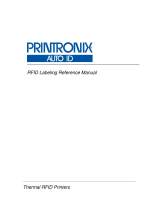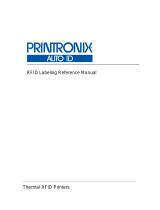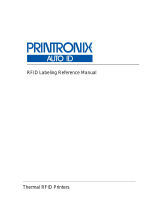Page is loading ...

RFID Label Guide Specification
Gen 2, Rafsec Short Dipole Antenna
182316-000 Rev C Page 1 of 5
Printronix Guide Specification
RFID Label
915 MHz, 96 Bit, EPC Class 1, Gen 2
Rafsec Short Dipole Antenna
Applicable Printer Models
Print and Apply Models Desktop Models
SLPA8000r MP2 SL4M MP2
SLPA7000r MP2 SL5000r MP2
Disclaimer
Notwithstanding anything to the contrary in this document, the guidelines, suggestions and other information
included in this document or otherwise provided to the recipient, including the guidelines and suggestions for
developing converted RFID labels, are provided by Printronix on an "as is" basis and without warranty of
any kind whatsoever, expressed or implied. In particular, Printronix disclaims any implied warranty of
merchantability or fitness for a particular purpose. Printronix will not be liable under any circumstances for
any damages or losses related in any way to use of the guidelines, specifications or other information,
including damages, which may be incurred as a result of labels not working properly in a specific
application. All specifications subjective to change without notice. Testing of the converted labels in the
printer is recommended prior to production quantities.
2/12/07

RFID Label Guide Specification
Gen 2, Rafsec Short Dipole Antenna
182316-000 Rev C Page 2 of 5
Printronix
RFID Label Guide Specification
915 MHz EPC Class 1, Gen 2
Rafsec Short Dipole Antenna
1. Scope
1.1. This document provides guide specifications for developing 96 Bit, EPC UHF Class 1,
Gen 2, RFID labels with Rafsec Short Dipole Antenna for use with Printronix MP2 series
of RFID printers.
1.2. Target Applications
1.2.1. Target application is supply chain logistics labeling using paper pressure-sensitive
RFID labels.
1.3. Target RFID Printer Models
1.3.1. Printronix SmartLine SL4M MP2 and SL5000r MP2 series RFID Smart Label
Printers. Printers are designed to encode, verify and print RFID labels.
1.3.2. Printronix SmartLine SLPA8000r MP2 and SLPA7000r MP2 series RFID Smart
Label Printer Applicator. Printers are designed to encode, verify, print and apply
RFID labels.
2. Disclaimer
2.1. Notwithstanding anything to the contrary in this document, the guidelines, suggestions
and other information included in this document or otherwise provided to the recipient,
including the guidelines and suggestions for developing converted RFID labels, are
provided by Printronix on an "as is" basis and without warranty of any kind whatsoever,
expressed or implied. In particular, Printronix disclaims any implied warranty of
merchantability or fitness for a particular purpose. Printronix will not be liable under any
circumstances for any damages or losses related in any way to use of the guidelines,
specifications or other information, including damages, which may be incurred as a result
of labels not working properly in a specific application. All specifications subjective to
change without notice. Testing of the converted labels in the printer is recommended
prior to production quantities.
3. Requirements
3.1. Label Facestock
3.1.1. Thermal Transfer printing mode – Coated label facestock designed for thermal
transfer printing (Fasson Thermal Transfer 1C media or equivalent).
3.1.2. Direct Thermal printing mode – Coated label facestock designed for direct thermal
printing (Fasson DirectTherm 200HD or equivalent).
3.2. Liner
3.2.1. 40 # bleached calendared Kraft stock.
3.3. Adhesive
3.3.1. Permanent Acrylic or rubber based adhesives are acceptable

RFID Label Guide Specification
Gen 2, Rafsec Short Dipole Antenna
182316-000 Rev C Page 3 of 5
3.3.2. Adhesive interface to liner shall be uniform and exhibit the same release
characteristics along the full length of the label.
3.4. Perforations Between Labels
3.4.1. For SL4M and SL5000 models – per user requirements except no perforations for
Peel Mode.
3.4.2. For SLPA8000 and SLPA7000 models – no perforation between labels.
3.5. Roll Configurations
3.5.1. SL4M and SL5000 models
3.5.1.1. Inside core diameter: 3 inches (76.2 mm).
3.5.1.2. Outside roll diameter: 8" (203.2 mm) maximum.
3.5.1.3. Label wind direction – label side out with orientation per Figure 1.
3.5.2. SLPA8000 and SLPA7000 models
3.5.2.1. Inside core diameter: 3.000” (+0.032”, -0.0”) (76.190 mm (+0.813, -
0.0)) core acceptable for label lengths less than 5" (127.0 mm) with
inlay lengths less than 2" (50.8 mm). For label lengths greater than 5"
(127.0 mm) core diameter shall be 6.0" (+0.032”, -0.0”) (152.4 mm
(+0.813, -0.0).
3.5.2.2. Outside roll diameter: up to 12" (304.8 mm) maximum.
3.5.2.3. Label wind direction – label side out with orientation per Figure 1.
3.5.3. General
3.5.3.1. Roll to be wound with sufficient tension to prevent telescoping during
transit and handling.
3.5.3.2. Splices to use clear tape, should be angled and placed under the labels
and not between.
3.6. Inlay
3.6.1. Inlay: Rafsec Gen 2 Short Dipole inlay (similar to Rafsec sales code 3000704).
3.6.2. Base antenna material: Etched aluminum.
3.6.3. Nominal operating frequency: 915 (+/-15) MHz.
3.6.4. EPC Protocol: UHF Class 1, Gen 2.
3.6.5. Memory: 96 Bit Read/Write.
3.7. Label Construction
3.7.1. Inlay location with respect to label facestock outlined in Figure 1.
3.7.2. 4” Printer Models
3.7.2.1. Nominal label facestock width with inlay is 4.0" (101.6 mm).
Maximum width of label construction supported by printer is 4.5"
(114.3 mm) edge to edge (4.1" (104.1 mm) is printable).
3.7.3. 6” Printer Models

RFID Label Guide Specification
Gen 2, Rafsec Short Dipole Antenna
182316-000 Rev C Page 4 of 5
3.7.3.1. Printable label facestock width with inlay is 6.6" (167.6 mm).
Maximum width of label construction supported by printer is 6.8"
(172.7 mm) edge to edge.
3.7.4. Minimum supported inlay pitch is 2.0" (50.8 mm).
3.7.5. Gap Sensing
3.7.5.1. Nominal gap between labels for gap sensing is 0.125" (3.17 mm).
Minimum gap supported is 0.10" (2.54 mm).
3.7.5.2. 1.0" (25.4 mm) minimum x 0.125" (3.17 mm) timing marks on the liner
under the gap.
3.7.6. Release Characteristics
3.7.6.1. Labels shall be able to dispense in a print and apply application.
3.8. Packaging and Handling
3.8.1. RFID labels are static sensitive devices and should be packaged and handled
accordingly.
3.8.2. Low humidity environments can increase electrostatic discharge (ESD) conditions.
ESD safeguards are recommended
3.8.3. Avoid storing labels in elevated temperature environment.
4. Thermal Transfer Ribbons for Printronix RFID Printers
4.1. Ribbons for 4” RFID Printer Models
4.1.1. Wax resin ribbon for best durability. Wax Resin Blend Ribbon 8500, 4.33" x 2051'
(110 mm x 625 m), package of 6 ribbons, Printronix part no. 203485-103.
4.1.2. General purpose wax ribbon. Wide Spectrum Wax Ribbon 8300, 4.33" x 2051'
(110 mm x 625 m), package of 6 ribbons, Printronix part No. 175391-103.
4.2. Ribbons for 6” RFID Printer Models
4.2.1. Wax resin ribbon for best durability. Wax Resin Blend Ribbon 8500, 6.73" x 2051'
(171 mm x 625 m), package of 6 ribbons, Printronix part no. 203485-106.
4.2.2. General purpose wax ribbon. Wide Spectrum Wax Ribbon 8300, 6.73" x 2051'
(171 mm x 625 m), package of 6 ribbons, Printronix part No. 175391-106.
5. Contact Information
5.1. For comments or questions, please contact Andrew Moore at amoore@printronix.com or
714-368-2477.

RFID Label Guide Specification
Gen 2, Rafsec Short Dipole Antenna
182316-000 Rev C Page 5 of 5
Figure 1. Label Layout
All Dimensions in Inches
Printronix RFID Label Requirements for
Rafsec Short Dipole Inlay
Viewed from Facestock Side
1.0" min x 0.125"
timing mark on
back side of liner
Direction of label
travel out of
printer
1.00" (+/-0.125")
Trailing edge of timing
mark to leading edge
of antenna
2.0625"
(+/- 0.1250")
Liner edge to
center of chip
Label Perforation
Centered in Gap
(see Para 3.4)
Leading Edge of Label
Minimum
Pitch 2.0"
Liner
Label
Inlay Outline
Rafsec Short Dipole
Antenna outline
Chip facing down,
center slot back
PRINTRONIX
4.0" minimum
Corner radius:
0.125" typ.
Variable see para
3.7.2 and 3.7.3
/


